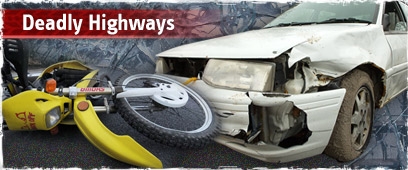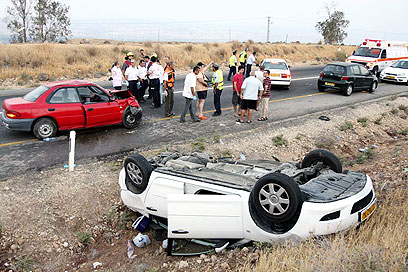

Is life cheap?
Government tired of spending billions on collateral damaged caused by road accidents, seems adamant on cutting back National Road Safety Authority funds. Benefits of NRSA program outweigh shortcomings, says head of Sheinin Committee; investment fails to coincide with results, rebuffs Treasury
Just how much does Israel spend every year on the damage caused by traffic accidents? Is this really the place to exercise governmental frugality? The cost of saving, it would seem, is not always in our favor.
As part of the bridling measures taken in the government's budget for 2009, the Finance Ministry announced it would be cutting some NIS 200 million (approx. $55.07 million) from the National Road Safety Authority's funding.
The estimated cost of road accidents to the Israeli market is NIS 10 billion ($2.79 billion) per-annum, but the Treasury claims that the NRSA leaves much of its budget unutilized.
The NRSA, however, disagrees: "The Finance Ministry's suggestion for reprioritizing (the budget) will eventually cause disproportionate losses of state funds," warned Ziva Patir, head of the National Road Safety Authority's, in a letter to Finance Minister Ronnie Bar-On.
So, what does a road fatality go for these days? Some 431 people were killed in road accidents in 2007. The figure is the lowest it has been for the past 40 years, but is staggering just the same. The monetary toll came to NIS 7.5 billion ($2.09 billion).
'Perfect financial sense'
The 2005 Sheinin Report on road accidents and safety stated that the average expenditure in any single case of road fatality nears NIS 4.7 million ($1.3 million). The cost of caring for road accidents' casualties ranges from NIS 17,000 to NIS 900,000 ($4,700 -$251,000), depending on the severity of the injuries.
The report, and the program derived from it, outlined a national goal of decreasing the number of road fatalities below the 360 mark by 2010, and below the 300 mark by 2015. The program is meant to save the State up to NIS 2 billion ($556 million) a year in overall expenses and collateral damage.
At the time, and with the Sheinin program in mind, the NRSA's budget was increased to NIS 550 million ($153 million) – a cost effective increase – and the program seems to be working, but with the Treasury threatening to tighten the purse strings, any continued success is no longer guaranteed.
"The committee's plane, which was the basis for forming the National Road Safety Authority calls for a 30% decrease in the number of fatalities by 2010," said Dr. Jacob Sheinin, who headed the Sheinin Committee.
"Both the budget and the outlines program stand to result in a huge savings in cost, not to mention the saving in human suffering and grief, which cannot be quantified. I don’t understand why the Treasury is pushing for a cutback when the program makes perfect financial sense.

National Road Safety Authority not cost effective? (Archive photo: Hagai Aharon)
"Furthermore," he continued, "if we look at this from a purely financial point of view, it is well-worth investing even a billion shekels ($278 million) in it."
The data indicated the National Road Safety Authority has been able to bring about a drop in road accident fatalities, from a record number of 518 people in 2004, through 476 people in 2005, 448 people in 2006 and 431 people in 2007.
Is the program still necessary, now that the numbers are dropping?
"The main reason for it is the massive campaigning," said Sheinin. "Once we got started, we had two years of free, massive campaign work. The public was made aware of deadly traffic accidents. We never left the public agenda."
Can the significant saving both in funds and in human lives really be attributed only to the campaign?
"I think, first and foremost, that awareness has a lot to do with it. Of course, we also have better infrastructure and better car safety these days."
The numbers in 2008 don't support the trend.
"You can't come in after one year and say 'okay, this isn't working' and cut the budget. We had two million cars on the road in 2005. We're going to have three million by 2015. With these kinds of numbers, we could expect 750 fatalities a year – the program anticipates 300 or less – which would definitely render it effective. But that takes money.
"The program is still in its first stages and it hasn't even been implemented in full," he added. "Either way, this is a long-term program, so you can't judge it by just one year."
The Finance Ministry left NIS 200 million ($55.07 million) in infrastructure funds. The cutbacks apply to other things.
"Yes, but thinking only about the present, taking care of infrastructure alone is wrong. The NRSA addresses many subjects, such as education, PR, enforcement, research and technology – Israel has one of the highest rates of seatbelt use – and that's due to the campaign."
'NRSA ineffective'
The Treasury, however, is not happy with the workings of the National Road Safety Authority: "In the past two years we have spent one billion shekels ($278.4 million) of the taxpayers' money on the National Road Safety Authority.
"Some 62% of the funds were spent in accordance with the budgetary plan and the rest was allotted to other governmental bodies for various projects. There is no need for an expensive government bureau, which employs 98 people, if it is not fully operational," a source in the Treasury told Ynet.
"There is little connection between the State's investment in the NRSA and the results it has produced; therefore there is no reason to keep spending hundreds of millions of shekels on a bureau which exists for the sole purpose of existing. The research has shown that in order to prevent and reduce the number of fatal road accidents, we have to invest in infrastructure, and that budget has not been cut.
"In 2007 the NRSA only utilized 75% of its NIS 300 million ($83.12 million) budget, continued the source. "As of now, with only four months to the end of the year, it has only used 32.3% of its annual budget…Since various organizations know they can be essentially funded by the NRSA, then the Police Department doesn't buy its own patrol cars and the Education Ministry doesn’t spring for safety teachings and crossing guards – they rely on the NRSA to do it for them.
"We are confident that the importance of crossing guards, patrol cars etc., would prompt the relevant (government) bureaus to fund them for themselves and that the National Road Safety Authority will continue funding these project as well, because, as noted, it is far from using its entire budget."















